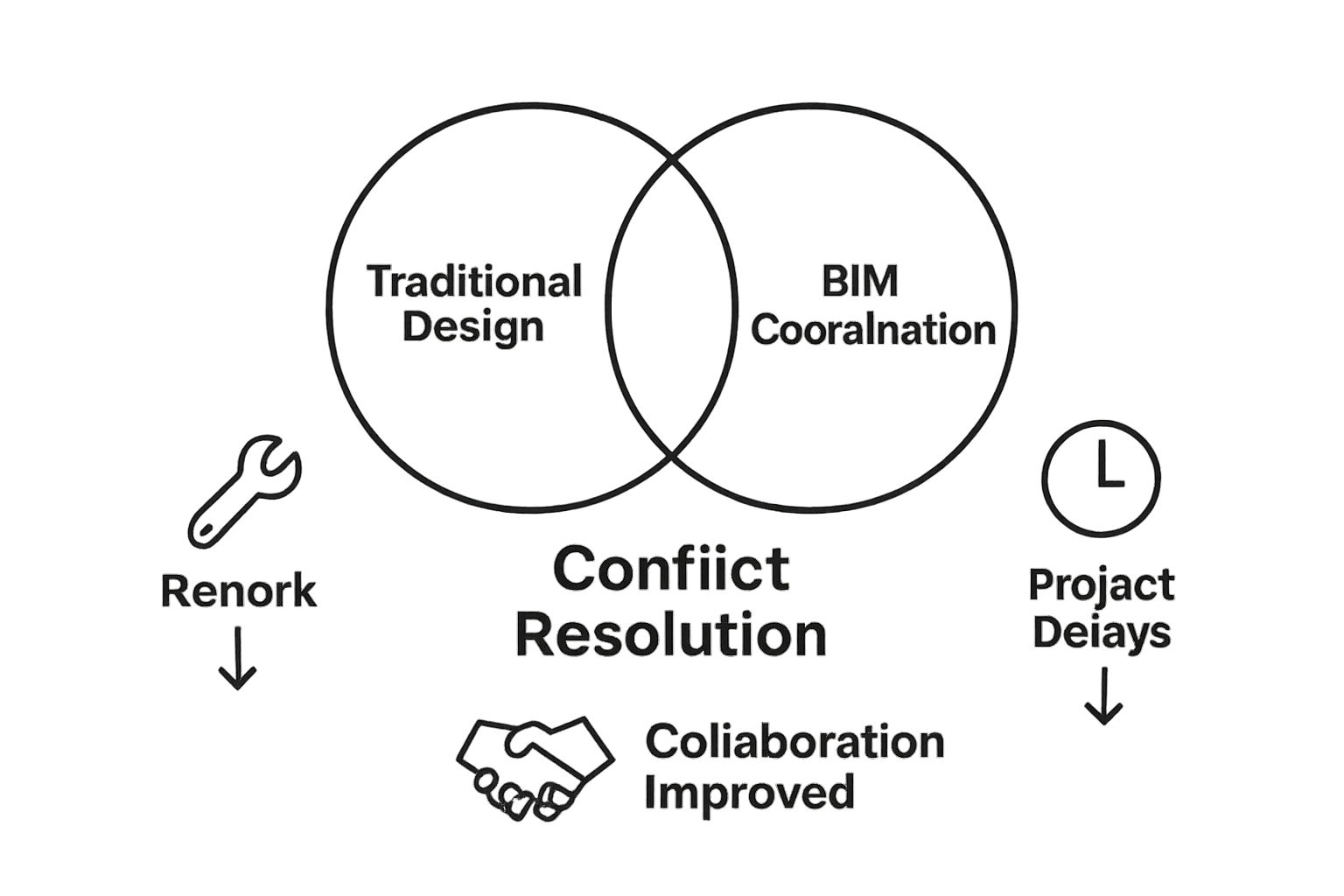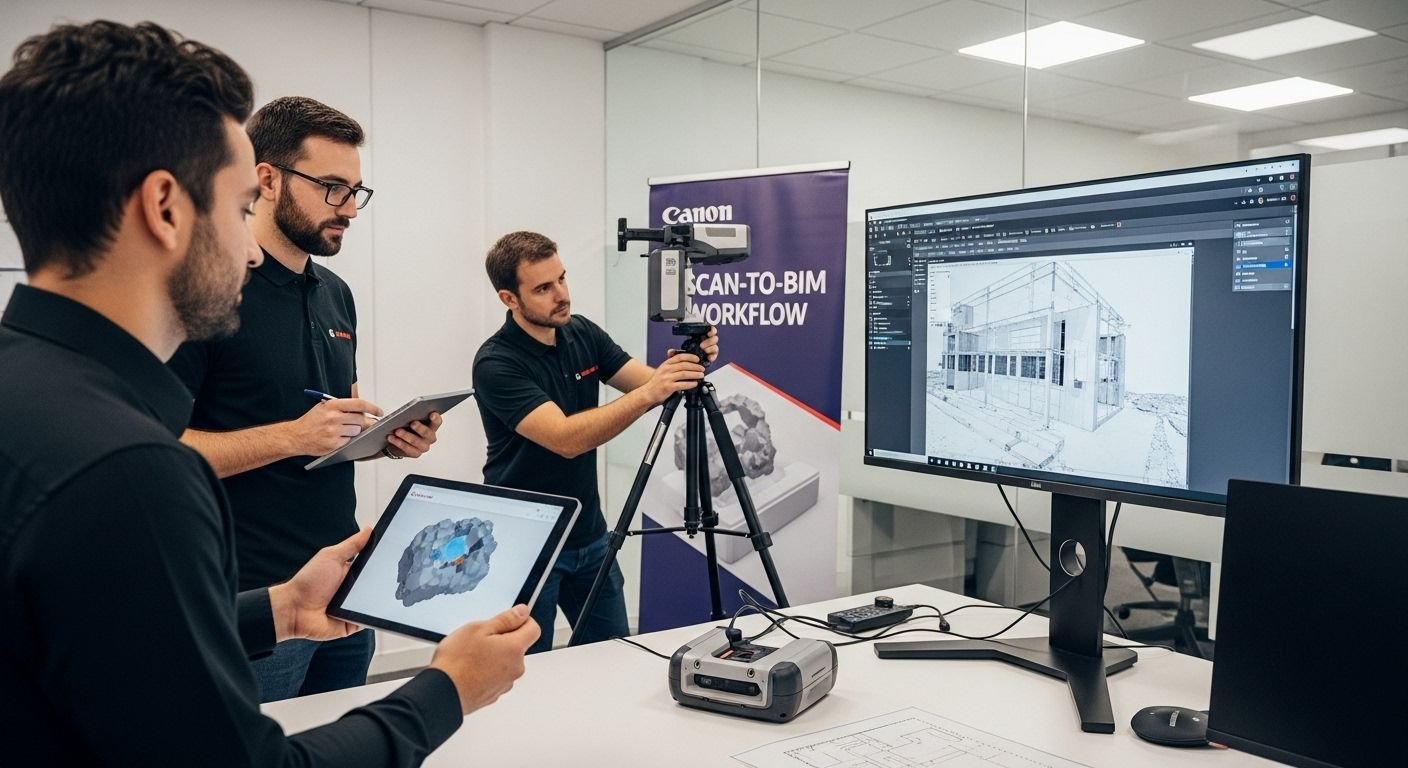BIM coordination is reshaping the way buildings are designed, planned, and brought to life on construction sites. While many expect the main benefit to be sleeker visuals or fancier models, the real surprise is all about risk management and efficiency. A staggering 65 percent of construction professionals use BIM to spot and sort out costly errors before a single brick is laid. This unseen digital teamwork is changing the very foundations of how the best projects come together.
Table of Contents
- What Is BIM Coordination And Its Key Concepts?
- The Importance Of BIM Coordination In Construction Projects
- How BIM Coordination Enhances Collaboration Among Stakeholders
- Real-World Applications Of BIM Coordination In High-End Residential Developments
- The Future Of BIM Coordination In Construction
Quick Summary
| Takeaway | Explanation |
|---|---|
| BIM enhances conflict resolution before construction | BIM coordination identifies potential design conflicts early, reducing costly modifications during physical construction. |
| Improves collaboration across disciplines | A unified digital platform facilitates seamless communication and information sharing among architectural, engineering, and construction teams. |
| BIM leads to significant cost savings | Early detection of design issues and streamlined processes help minimise rework and expenses, contributing to overall project efficiency. |
| Increases design accuracy with advanced technology | Utilising sophisticated modelling and simulation tools allows for precise representation and optimisation of building designs. |
| Fosters sustainable construction practices | BIM enables analysis of environmental performance, supporting energy efficiency and sustainable design decisions throughout the project lifecycle. |
What is BIM Coordination and Its Key Concepts?
Building Information Modelling (BIM) coordination represents a sophisticated digital approach transforming how construction professionals design, plan, and execute complex projects. By creating intelligent 3D models that integrate architectural, structural, and engineering data, teams can visualise, analyse, and resolve potential conflicts before actual construction begins.
Understanding BIM Coordination Fundamentals
BIM coordination goes beyond traditional drafting methods by generating comprehensive digital representations of building components. According to the National Institute of Building Sciences, this process involves verifying design layouts and spatial arrangements through advanced computational techniques.
Key characteristics of BIM coordination include:
- Comprehensive 3D digital modelling of entire building systems
- Real-time clash detection between architectural and engineering elements
- Automatic information synchronisation across project disciplines
- Enhanced visualisation of complex spatial relationships
The primary objective is to identify and resolve potential design conflicts virtually, preventing expensive modifications during physical construction. By integrating multiple disciplinary perspectives into a unified digital environment, teams can collaborate more effectively and reduce project risks.
Technical Components and Implementation
Successful BIM coordination relies on sophisticated software tools that enable precise model integration. These platforms allow professionals to:
- Overlay different disciplinary models (architectural, structural, mechanical)
- Perform automated interference checks
- Generate comprehensive clash reports
- Track and manage design modifications
Professionals utilise advanced algorithms to detect potential conflicts between mechanical, electrical, plumbing, and structural elements. This proactive approach significantly minimises construction errors, reduces project delays, and optimises overall project efficiency.
By transforming complex building design into intelligent, interconnected digital models, BIM coordination represents a revolutionary approach to construction management, enabling unprecedented levels of precision, collaboration, and strategic planning.
The Importance of BIM Coordination in Construction Projects
BIM coordination has emerged as a transformative approach in modern construction, offering unprecedented capabilities for managing complex architectural and engineering challenges. By integrating digital technologies with strategic project management, construction professionals can achieve remarkable improvements in design precision, collaboration, and overall project efficiency.
Strategic Project Risk Mitigation
According to a survey by buildingSMART International, 65% of industry professionals utilise BIM specifically to capture and resolve quality issues before they become costly problems. This proactive approach allows teams to:
- Identify potential design conflicts early in the development process
- Reduce expensive rework during construction phases
- Minimise potential structural or system compatibility issues
- Provide comprehensive visual representations of complex design interactions
The ability to detect and resolve potential problems virtually represents a significant advancement in construction project management, enabling teams to anticipate challenges before they manifest physically.
To clarify the multifaceted advantages of BIM coordination highlighted in this section, the table below organises strategic benefits with concise explanations for each, supporting quick reference and comparison.
| Strategic Benefit | Description |
|---|---|
| Early Conflict Detection | Identifies design conflicts before construction, preventing costly rework and delays. |
| Reduced Rework and Expensive Modifications | Minimises on-site changes and avoids unforeseen expenses by resolving issues digitally first. |
| Minimized Compatibility Issues | Ensures structural and system elements align, reducing technical risks across project disciplines. |
| Comprehensive Visualisation | Offers clear, three-dimensional visualisation of complex design interactions for better decision-making. |
| Enhanced Risk Management | Supports risk identification and mitigation through detailed virtual simulation and coordination. |
| Improved Communication and Documentation | Provides unified documentation, ensuring all changes and decisions are visible to stakeholders. |
Enhanced Collaboration and Communication
BIM coordination transcends traditional communication methods by creating a unified digital environment where multiple disciplines can interact seamlessly. This approach breaks down traditional silos between architectural, structural, mechanical, and electrical teams, fostering a more integrated and transparent workflow.
Key communication benefits include:
- Real-time model sharing across different project stakeholders
- Comprehensive documentation of design decisions
- Improved transparency in project development
- Faster resolution of complex design challenges
By establishing a single source of truth, BIM coordination ensures that all team members have access to the most current and accurate project information, dramatically reducing miscommunication and potential errors.
Economic and Efficiency Advantages
The economic implications of effective BIM coordination are substantial. By minimising design conflicts and streamlining communication, construction projects can achieve significant cost savings and efficiency gains. The digital approach allows for more precise planning, reduced material waste, and optimised resource allocation.

Ultimately, BIM coordination represents more than a technological tool – it is a strategic approach that fundamentally transforms how construction projects are conceived, developed, and executed, delivering unprecedented levels of precision and collaborative potential.
How BIM Coordination Enhances Collaboration Among Stakeholders
In the complex landscape of modern construction, BIM coordination emerges as a powerful mechanism for transforming collaborative practices, breaking down traditional communication barriers, and creating a unified approach to project development. By establishing a shared digital environment, BIM enables unprecedented levels of transparency, communication, and collective problem solving among diverse project stakeholders.
Breaking Down Disciplinary Silos
According to a systematic literature review published in the journal Buildings, collaborative efforts in BIM model development address critical practical challenges that historically hindered effective interdisciplinary communication. This approach fundamentally restructures how professionals from different domains interact and contribute to project development.
Key advantages of interdisciplinary collaboration through BIM include:
- Seamless information exchange across architectural, structural, and engineering domains
- Reduction of communication gaps between design and construction teams
- Enhanced visibility of design decisions and potential conflicts
- Standardised communication protocols
By creating a comprehensive digital platform, BIM coordination ensures that every stakeholder has access to real-time, accurate project information, dramatically reducing misunderstandings and potential errors.
Integrated Decision Making Process
BIM coordination transforms decision-making from a fragmented process to a holistic, collaborative approach. Instead of working in isolated environments, professionals can now collectively analyse, evaluate, and resolve complex design challenges in a shared digital space.
Critical collaborative features include:
- Simultaneous model editing and version control
- Automated clash detection and resolution mechanisms
- Transparent tracking of design modifications
- Comprehensive audit trails of project evolution
This integrated approach allows teams to make more informed, collective decisions, reducing the likelihood of costly mistakes and ensuring alignment with project objectives.
Enhancing Stakeholder Engagement
Beyond technical collaboration, BIM coordination facilitates more meaningful engagement with a broader range of project stakeholders. Clients, investors, and regulatory bodies can now visualise and understand complex design propositions through immersive, intelligent 3D models.
The digital platform enables stakeholders to:
- Explore detailed project visualisations
- Provide immediate feedback
- Understand complex spatial relationships
- Participate more actively in design discussions
Ultimately, BIM coordination represents a paradigm shift in construction collaboration, transforming traditional linear communication models into dynamic, interactive, and intelligent project development ecosystems.

Real-World Applications of BIM Coordination in High-End Residential Developments
BIM coordination has revolutionised the landscape of high-end residential developments, transforming how architects, engineers, and developers conceptualise, design, and execute sophisticated living spaces. By leveraging advanced digital technologies, professionals can now create more complex, efficient, and personalised residential environments with unprecedented precision and flexibility.
Design Complexity and Customisation
According to research exploring BIM integration in residential design, the implementation of advanced BIM methodologies enables unprecedented levels of design complexity and customisation in residential projects. This approach allows for intricate spatial planning and sophisticated architectural solutions that were previously challenging to achieve.
Key advantages in design complexity include:
- Ability to model complex geometric forms and architectural features
- Precise representation of unique material interactions
- Advanced environmental performance simulation
- Detailed parametric design capabilities
High-end residential developments now benefit from computational design techniques that enable architects to push traditional architectural boundaries, creating truly bespoke living environments that respond dynamically to client requirements and site-specific conditions.
Performance and Sustainability Optimization
BIM coordination plays a crucial role in optimising residential building performance, particularly in high-end developments where sustainability and energy efficiency are paramount. By creating comprehensive digital models, professionals can simulate and analyse various environmental and architectural parameters with remarkable accuracy.
Critical performance optimization strategies include:
- Thermal performance modelling
- Natural light and solar radiation analysis
- Acoustic design verification
- Energy consumption prediction
- Material efficiency assessment
These advanced simulations enable developers to make data-driven decisions that enhance residential comfort, reduce environmental impact, and improve long-term operational efficiency.
To support understanding of the range of performance and sustainability strategies applied in high-end residential BIM coordination, this table presents key optimisation areas alongside corresponding benefits.
| Optimisation Strategy | Benefit |
|---|---|
| Thermal Performance Modelling | Enables energy-efficient design and improved resident comfort |
| Natural Light and Solar Analysis | Enhances daylight utilisation and supports passive solar design |
| Acoustic Design Verification | Improves sound insulation and overall indoor environmental quality |
| Energy Consumption Prediction | Allows accurate forecasting of long-term running costs and environmental impact |
| Material Efficiency Assessment | Promotes resource optimisation and waste reduction |
Cost Management and Risk Mitigation
In high-end residential developments, BIM coordination provides sophisticated tools for precise cost estimation, budget management, and risk reduction. By creating detailed digital representations of entire projects, teams can identify potential conflicts, streamline construction processes, and minimise unexpected expenses.
Key financial benefits encompass:
- Accurate quantity takeoffs and material estimations
- Early detection of potential design conflicts
- Reduced rework and construction delays
- Comprehensive project lifecycle cost analysis
Ultimately, BIM coordination represents a transformative approach in high-end residential development, offering unprecedented levels of design intelligence, performance optimization, and economic strategic planning.
The Future of BIM Coordination in Construction
The evolution of Building Information Modelling (BIM) coordination represents a transformative journey towards more intelligent, interconnected, and data-driven construction practices. As technological capabilities expand, BIM is poised to revolutionise how construction professionals conceptualise, design, manage, and maintain built environments.
Emerging Technological Integration
According to a 2021 survey by buildingSMART International, 77% of industry professionals anticipate significant technological advancements in project information management. The future of BIM coordination will be characterised by sophisticated technological integrations that transcend traditional design and construction boundaries.
Key technological convergence areas include:
- Artificial Intelligence driven design optimisation
- Advanced machine learning predictive analytics
- Real-time collaborative cloud platforms
- Seamless Internet of Things (IoT) integration
- Blockchain for secure information management
These emerging technologies will enable more dynamic, responsive, and intelligent construction ecosystems, fundamentally transforming how projects are conceived and executed.
Intelligent Predictive Capabilities
Future BIM coordination will move beyond visual representation to become a powerful predictive tool. By combining advanced computational techniques with comprehensive data analysis, construction professionals will be able to anticipate potential challenges, optimise design strategies, and make more informed decisions throughout the project lifecycle.
Advanced predictive capabilities will encompass:
- Comprehensive risk assessment algorithms
- Automated design conflict resolution
- Precise performance and sustainability forecasting
- Dynamic resource allocation strategies
- Intelligent maintenance and lifecycle management
This shift towards predictive intelligence will enable more proactive, efficient, and sustainable construction approaches, reducing potential errors and maximising project potential.
Sustainability and Holistic Performance
BIM coordination is set to become a critical tool in addressing global sustainability challenges. By providing comprehensive environmental performance modelling and advanced simulation capabilities, BIM will enable construction professionals to design and develop buildings with unprecedented ecological and economic efficiency.
Holistic performance considerations will include:
- Carbon emission tracking and reduction strategies
- Advanced energy consumption modelling
- Circular economy design principles
- Comprehensive lifecycle assessment tools
- Smart building integration techniques
Ultimately, the future of BIM coordination represents more than technological advancement – it signifies a fundamental reimagining of how we conceive, construct, and interact with our built environment, positioning technology as a strategic enabler of more intelligent, sustainable, and human-centric design solutions.
Transform Your High-End Project With Expert BIM Coordination
Complex residential and hospitality projects come with unique challenges. The article highlighted the struggle to achieve seamless collaboration, avoid costly rework, and tackle design conflicts before they impact your timeline or budget. BIM coordination, clash detection, and integrated digital modelling were cited as solutions that deliver clarity, reduce risk, and drive project success. Yet, implementing these in real life demands not just technology, but a trusted partner who understands the stakes for investors, architects, and contractors striving for perfection.
At Reltic BIM, our team specialises in guiding high-value developments through every stage with unrivalled BIM expertise. From 3D modelling and 4D scheduling to 5D cost control and digital handover, we deliver exceptional precision aligned with the latest ISO 19650 standards. Discover how our tailored BIM coordination services can help you prevent errors, ensure stakeholder alignment, and maximise the value of your luxury project. Ready to turn digital clarity into a competitive advantage? Visit Reltic BIM now and book your consultation today.
Frequently Asked Questions
What is BIM coordination?
BIM coordination refers to the process of integrating and managing all aspects of Building Information Modelling (BIM) in construction projects. It involves creating intelligent 3D models that incorporate architectural, structural, and engineering data to identify and resolve design conflicts before construction begins.
How does BIM coordination enhance collaboration among project stakeholders?
BIM coordination facilitates seamless information exchange and real-time model sharing across various disciplines. By creating a unified digital environment, it breaks down communication barriers, promotes transparency, and allows for more effective collaboration in addressing complex design challenges.
What are the economic benefits of implementing BIM coordination in high-end projects?
BIM coordination can lead to significant cost savings in high-end projects by minimising design conflicts, reducing material waste, and optimising resource allocation. Effective BIM practices streamline construction processes, improve planning accuracy, and ultimately enhance project efficiency.
Why is sustainability important in BIM coordination for high-end residential developments?
Sustainability is a key focus in high-end developments, and BIM coordination supports this by enabling detailed environmental performance modelling and advanced simulations. This allows professionals to design buildings that minimise environmental impact, optimise energy efficiency, and adhere to sustainability principles throughout the project lifecycle.







